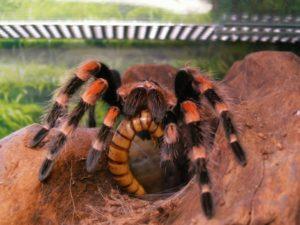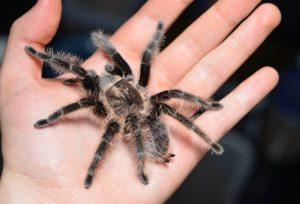Tarantula and domestic tarantula: what kind of spiders can be kept at home
Many people have a special relationship with spiders, from disgust to outright hatred or fear. There are even those who have a terrible fear, even a phobia. But there is another contingent of people - exotic lovers who have spiders as pets.
Content
What to consider when choosing a spider
Not all types of spiders are suitable for keeping at home. There are several requirements that apply to those animals that I plan to have at home:
- Presentable appearance. They should be large, bright or furry.
- Unpretentiousness. The spider should feel comfortable, it should have a small area and a small amount of space, for hunting, for example.
- Safety. Exotic and exotic for that, to choose the most unusual pet for yourself. But it should be understood that he should not carry a mortal threat.
- Life. Some spiders, especially males, do not live long. It is necessary to choose the species that lives long enough.
Who can be kept at home
Recently, the maintenance of spiders has become accessible and simple. You can choose from several types.
Conditions for keeping spiders
Arthropods do not need a lot of space for walking, most representatives calmly spend their time in a hole or in a hollow. But there are a number of conditions that need to be taken into account. Here's what you need to keep a spider:
- capacity;
- filler;
- drinker;
- thermometer;
- decor;
- lighting;
- brush;
- insulation box.
The minimum is twice the span of the animal's legs. Not high so that it does not beat on impact.
For comfort and maintenance of convenience, a filler is needed. It can be coconut or vermiculite.
Any place that will be a dwelling must have a cover so that the spider does not have the opportunity to walk around the house on foot.
Despite the fact that you need an airtight terrarium, we must not forget that the spider needs fresh air. If there are no holes in the container, they need to be made.
The amount of lighting depends on the type of spider. Some residents do not need lighting, they navigate in the dark, while others love to sunbathe.
There is a general indicator of 23-26 degrees. But in the cold season, additional heating may be required and, accordingly, vice versa.
It should be in moderation. The spider may have indicators in behavior - it will either drag the drinker into the hole or sit on the walls.
Requirements for keeping a spider at home
When all stages of preparation are completed, you need to arm yourself with knowledge about the features of caring for an exotic pet.
Food
Spiders are mostly predators. For food choose a variety of cockroaches, larvae, flies and worms. They are bought in special stores.
It is better not to feed the pets with those bugs that are caught in the house. They can be sick, carry an infection. Moreover, some food may be unusual, heavy for a spider.
The amount of food is selected depending on the size and age of the exotic. Usually young are fed 3 times a week, adults 1-2 times. Food is served with tweezers, do not overfeed and clean up leftovers after eating.
Cleaning
If food remains are removed in a timely manner, then there will be no need for frequent cleaning. Depending on size and substrate, it will need to be harvested every 9-12 months. The spider is pushed to the container in which it will stay and the substrate is replaced.
Molting
When the molting period of the spider comes, it becomes especially vulnerable. Understanding the offensive is simple - the pet stops eating, moves a little. Some lie on their backs, while others make a nest of cobwebs. It goes like this:
- the spider starts the process under the influence of hormones;
- the old skeleton slowly peels off;
- young do not touch until it hardens;
- the spider cannot be helped, even touched;
- when the pet stands firmly on its feet, you can remove the old skeleton.
A young animal tolerates molting faster and easier. If it does not occur for a long time, then it may be necessary to adjust the conditions.
Spiders and a warm attitude towards them
Pets are made for love and warm feelings. But these pets will not appreciate the manifestations of tenderness. Spiders can react in different ways:
- bite under stress;
- being accidentally injured;
- changes in temperature and humidity can be frightening;
- the spider might just run away.
What to do with a bite
If the security measures were violated, I really wanted to touch the spider and the result turned out to be deplorable, it is necessary to provide first aid.
The species of spiders living in the house are not poisonous, but the bite is at least unpleasant. Necessary:
- Pull the limb above the bite so that the poison does not spread.
- Wash the area with soap and treat with an antiseptic.
- Apply ice to relieve itching.
- Drink plenty of water to remove the poison.
https://youtu.be/Qkq-kD7tjnI
Pet spider: advantages and disadvantages
Before you start an exotic pet in the house, you need to carefully consider everything. He has pluses and minuses.
Positive:
- leaving will not take much time;
- the content is simple;
- the animal is calm and silent;
- do not cause allergies;
- exotic will undoubtedly surprise;
- it's fun to watch him.
Negative:
- risky, may bite or run away;
- may not live long;
- not manual;
- can inspire horror;
- cannot be trained.
Conclusion
A spider as a pet is unusual, funny and even eccentric. But it is necessary to be aware of the risks and weigh the pros and cons in order to provide yourself and your pet with complete safety and decent conditions.
Previous

